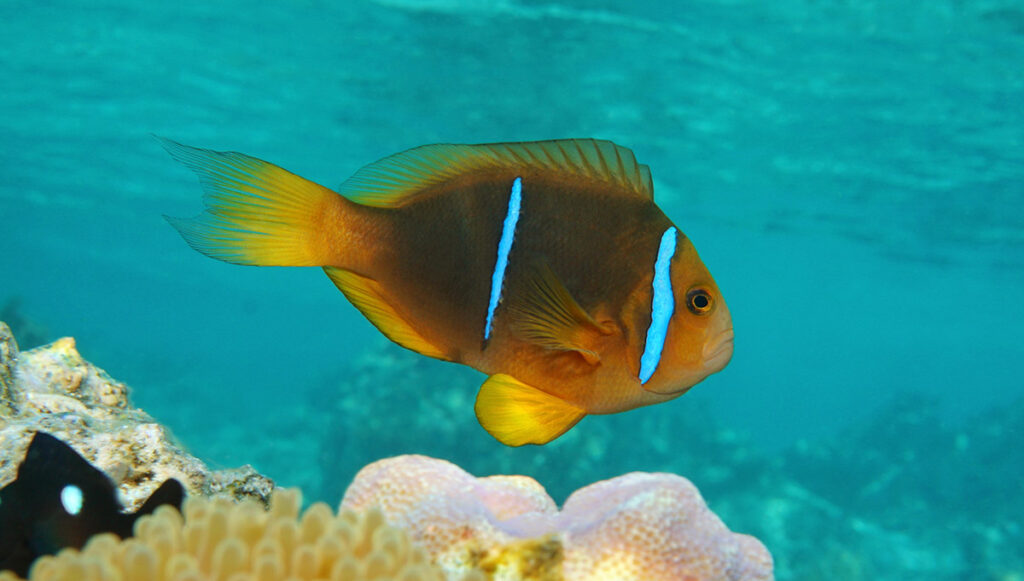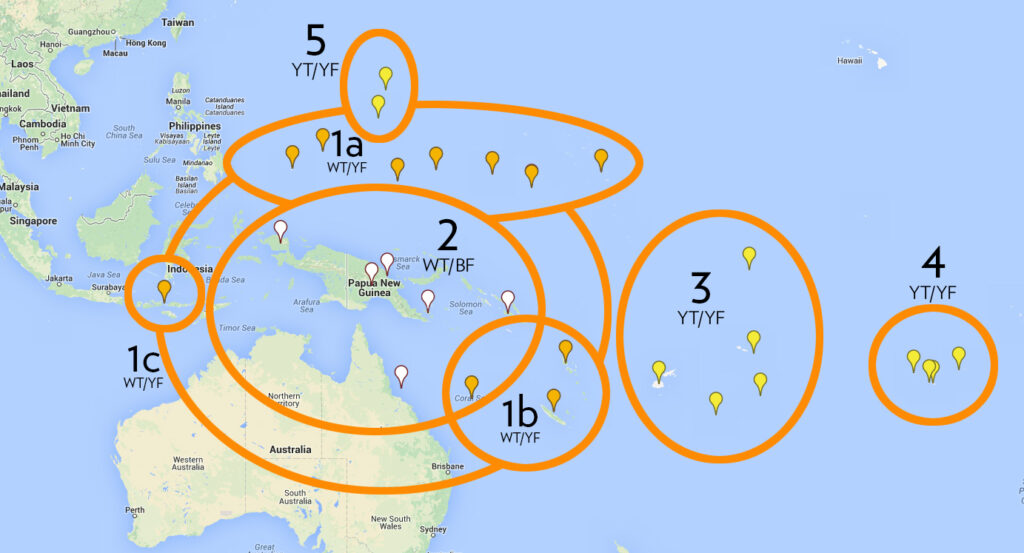
I’m excited to share this one, as it represents a little bit of personal validation. 11 years after I first authored my extensive series on the expansive biogeographic diversity of clownfishes, one of the species that I suggested might be hiding in plain sight has been confirmed. This week, authors James L. O’Donnell, Ricardo Beldade, Jason Johns, and Giacomo Bernardi published the findings of their research in the open-access Zookeys article, “A new species of Anemonefish from French Polynesia, Amphiprion maohiensis, (Pomacentridae, Amphiprioninae), the Polynesian anemonefish.”
In 2014, I concluded the 5th installment of my Clownfish/Anemonefish Biogeographic review, which focused on the Blue-Stripe/Bluestripe Amphiprion chrysopterus species complex, with a map. This graphic was created at a time before the massive wealth of citizen-scientific observations that are now available via iNaturalist, where divers can share geographic observations of species, creating a deep repository of information. But even back then, building on the work of those before me and what little additional information could be uncovered online, I had been able to identify specific population clusters, which I ultimately arranged in this fashion:

The group of clownfish we are specifically discussing today is represented by the population cluster marked #4 on my map. Joe Rowlett, who took this work a step further in 2016 with his website Amphiprionology, suggested a total of 6 distinct populations within what has been, until now, all lumped together as Amphiprion chrysopterus. From Rowlett’s work, the group was considered as the Polynesian Bluestripe Anemonefish.
The researchers and authors of this new species description have concluded that the eastern-most grouping of Blue Stripe Clownfish, those found in French Polynesia, are in fact a distinct, “cryptic species” worthy of unique taxonomic status. While casual observers like myself can look and say, “Hey, there’s a new species here,” it takes a lot of work to prove the hypothesis. The authors detailed the process used to determine whether there was something new.
“First, we examined the morphology of museum and collected specimens of A. chrysopterus from across the documented range. Second, we made observations of the coloration of individuals in the field and capitalized on georeferenced pictures available online. Lastly, we conducted a phylogenetic analysis of individuals from across the species’ range using mitochondrial markers and full nuclear genome resequencing. Taken together, these data indicate the presence of a new species in French Polynesia that we describe below.”
Ultimately, the researchers concluded that there are multiple phylogenetic clusters beyond the one they were specifically examining. This isn’t all that surprising, given that I wrote in 2014, “I am very comfortable in suggesting that we will see, at some point in the future, a new species described out of the Chrysopterus complex, and maybe two new species.”
So too, the paper includes suggestive remarks, including, “Sequences separate into three clade: one clade from Fiji and Tonga, one clade from Papua New Guinea, the Solomon Islands and Micronesia…and one clade, that represents the new species, from French Polynesia”, and, “Caudal fin coloration was not found to be a distinctive character of the species, because orange caudal fin is found in individuals from Fiji and adjacent areas, as well as in the Marianas. Additional investigations are warranted to fully elucidate the status of populations in those areas.”
For now, we have two species of Blue Stripe Clownfish, but it seems quite likely that with additional research, at least one more will get added in the future! Be sure to read the full open-access paper!
Reference
O’Donnell JL, Beldade R, Johns J, Bernardi G (2025) A new species of Anemonefish from French Polynesia, Amphiprion maohiensis, (Pomacentridae, Amphiprioninae), the Polynesian anemonefish. ZooKeys 1244: 225-237. https://doi.org/10.3897/zookeys.1244.141409





This is incredibly insightful. I wish I had know this report a while back. But yes, it is very likely that A. chrysopterus is a species complex of 2, 3, or 4 species…..
Very nice indeed!